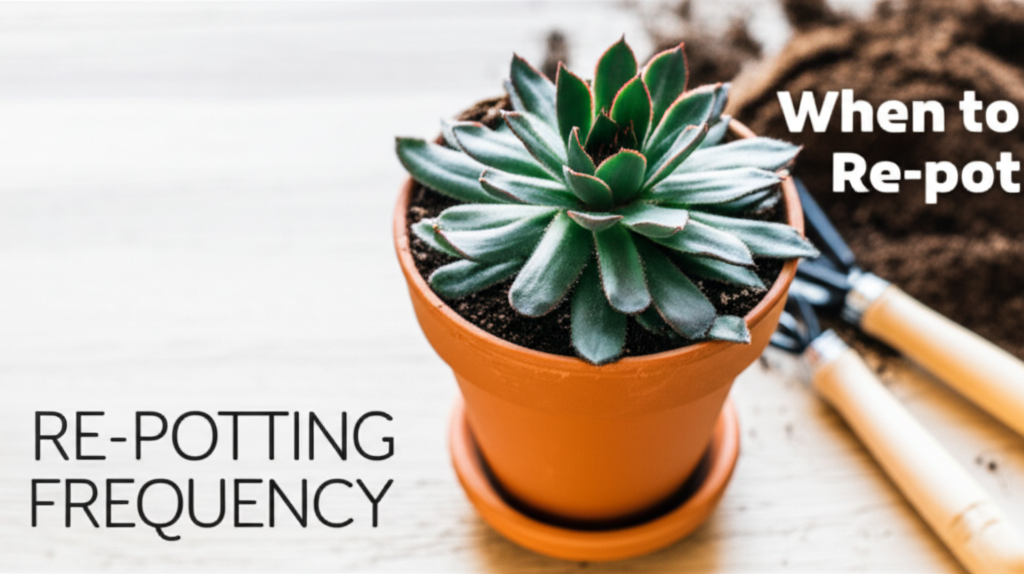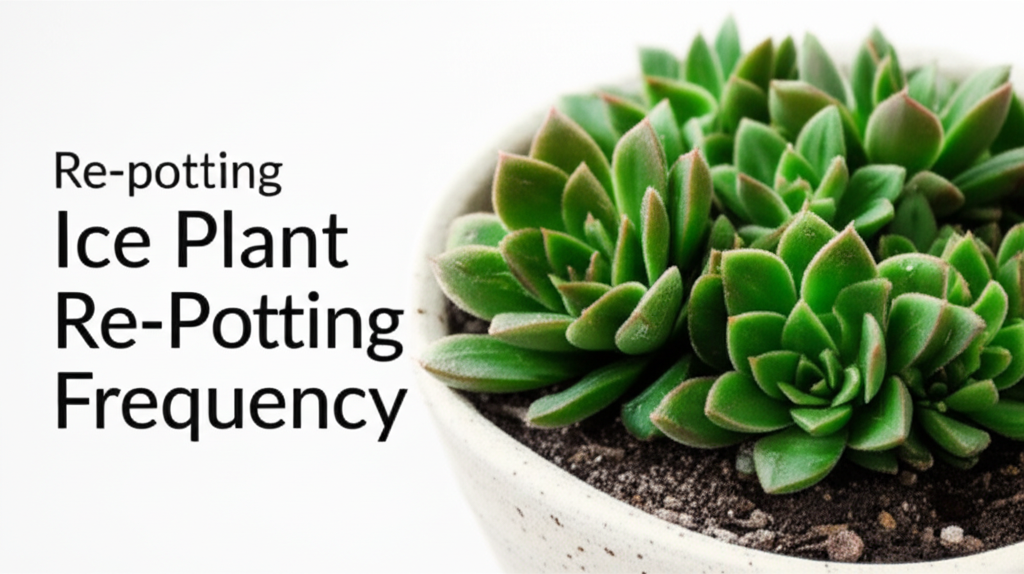Understanding Ice Plant Succulents and Their Re-potting Needs
Ice plants, belonging to the Aizoaceae family, are a diverse group of succulents celebrated for their vibrant, jewel-like leaves and often dazzling flowers. Their unique adaptations for arid environments mean they store water in their fleshy leaves, allowing them to thrive with minimal care. However, even the most resilient plants benefit from occasional attention, and re-potting is a crucial aspect of maintaining their health and promoting vigorous growth.
But how often is “occasional”? The answer isn’t a one-size-fits-all decree. Re-potting frequency for ice plant succulents is influenced by a variety of factors, from the plant’s growth rate to the type of soil it’s in and the size of its current container. Understanding these nuances will help you provide your ice plant with the optimal environment to flourish.
Why Re-potting is Necessary
Re-potting is more than just giving your succulent a bigger home. It serves several vital functions:
- Soil Replenishment: Over time, potting soil breaks down, losing its structure and nutrients. Re-potting provides fresh, well-draining soil, essential for succulent health.
- Root Health: As plants grow, their roots can become pot-bound, circling within the confines of the pot. This restricts nutrient and water uptake, leading to stunted growth and potential root rot.
- Disease Prevention: Old, compacted soil can harbor fungal spores and pests. Fresh soil offers a cleaner slate.
- Improved Drainage: Succulents are highly susceptible to overwatering. Re-potting with a suitable succulent mix ensures excellent drainage, preventing waterlogged roots.
- Space for Growth: As your ice plant matures, it will naturally outgrow its current container, requiring more space for its root system to expand.
Key Factors Influencing Re-potting Frequency

The ideal re-potting schedule for your ice plant succulent is not dictated by a calendar date but by observing the plant itself and its environment. Here are the primary factors to consider:
1. Plant Growth Rate
The most significant indicator of re-potting need is how quickly your ice plant is growing.
- Fast Growers: Some ice plant varieties, particularly those with rapid growth habits, may require re-potting every 1-2 years. You’ll notice them quickly filling their pots, with roots emerging from drainage holes or the surface of the soil.
- Slow Growers: Other ice plant succulents have a more sedate growth pattern and might only need re-potting every 3-4 years, or even longer. It’s essential to identify the specific variety of your ice plant to gauge its typical growth rate.
2. Pot Size and Drainage
The size of the pot and its drainage capabilities play a crucial role in how often re-potting is necessary.
- Root-Bound Indicators: If roots are visibly growing out of the drainage holes, or if the plant seems to be drying out much faster than usual, it’s a strong sign that the pot is too small.
- Compacted Soil: Over time, even well-draining soil can become compacted, especially if the plant is watered frequently. This reduces aeration and can lead to root problems.
- Container Material: Terracotta pots dry out faster than plastic or glazed ceramic pots, which can influence watering frequency and, indirectly, re-potting needs.
3. Soil Quality and Type
The quality of your potting mix is paramount for succulent success.
- Well-Draining Mix: A good succulent mix typically contains ingredients like perlite, pumice, and coarse sand to ensure excellent drainage. If your current mix retains too much moisture, re-potting with a better blend becomes more important.
- Nutrient Depletion: Even in a good mix, nutrients will eventually be depleted. Re-potting replenishes these vital elements, supporting healthy foliage and flowering.
4. Age of the Plant
Younger, actively growing plants generally require more frequent re-potting than mature, established specimens.
- Juvenile Plants: Young ice plants often need re-potting annually as they establish their root systems and grow rapidly.
- Mature Plants: As ice plants reach maturity, their growth slows down, and they can typically go for longer periods between re-potting sessions.
When to Re-pot: Signs to Look For
Instead of adhering to a strict schedule, pay close attention to your ice plant. These are the tell-tale signs that it’s time to re-pot:
Visible Root Issues
This is arguably the most definitive indicator.
- Roots Emerging from Drainage Holes: If you see roots peeking out from the bottom of the pot, it means the plant has outgrown its container and its root system is constricted.
- Roots Coiling on the Surface: Roots that are circling the top of the soil, becoming dense and compacted, are another clear sign of a pot-bound plant.
- Water Draining Too Quickly: While good drainage is essential, if water seems to rush through the pot almost immediately after watering, it can indicate that the roots have taken up so much space that there’s little soil left to absorb moisture.
Plant Health Decline
A plant struggling in an old pot will often show signs of stress.
- Stunted Growth: If your ice plant that was once growing vigorously has suddenly stopped producing new leaves or flowers, despite adequate light and water, it could be a sign of being pot-bound or having depleted soil.
- Yellowing or Drooping Leaves: While overwatering can cause these symptoms, persistently yellowing or drooping leaves, especially in the lower parts of the plant, can also indicate that the roots are not getting enough nutrients or water due to being constricted.
- Dryness Despite Watering: If you water your plant, but the soil dries out extremely rapidly, it’s a sign that the root system is too dense to hold sufficient moisture.
Soil Degradation
The condition of the potting mix is a critical clue.
- Compacted Soil: If the soil has become hard, dense, and seems to repel water, it’s a sign that it has broken down and needs replacing.
- White Crusty Build-up: This can be a sign of mineral salt accumulation from fertilizers or tap water, indicating that the soil is no longer providing a balanced environment.
The Ideal Re-potting Frequency: A General Guideline
While direct observation is key, here’s a general guideline for re-potting frequency for ice plant succulents:
| Plant Age/Growth Rate | Recommended Re-potting Frequency |
|---|---|
| Young/Fast-growing plants | Every 1-2 years |
| Mature/Moderately growing plants | Every 2-3 years |
| Mature/Slow-growing plants | Every 3-4 years, or as needed |
It’s important to remember that these are averages. If you notice any of the signs mentioned above, don’t hesitate to re-pot your ice plant, even if it falls outside this general timeframe.
How to Re-pot Your Ice Plant Succulent
Re-potting can seem daunting, but with the right approach, it’s a straightforward process.
What You’ll Need:
- A new pot (1-2 inches larger in diameter than the current one) with drainage holes.
- Fresh, well-draining succulent or cactus potting mix.
- Gloves (optional, some ice plants can be spiny).
- A trowel or spoon for scooping soil.
- Newspaper or a drop cloth to contain mess.
Step-by-Step Re-potting Guide:
| Step | Action |
|---|---|
| 1 | Prepare the New Pot: Ensure the new pot has drainage holes. Add a layer of fresh succulent mix to the bottom of the pot. |
| 2 | Remove the Plant: Gently tip the current pot on its side and carefully slide the ice plant out. If it’s stuck, tap the sides of the pot or run a knife around the edge. Avoid pulling the plant by its leaves. |
| 3 | Inspect and Prune Roots: Gently loosen any circling roots with your fingers or a small tool. Trim away any dead, mushy, or damaged roots with clean, sharp scissors or pruning shears. This encourages new root growth. |
| 4 | Position the Plant: Place the ice plant in the center of the new pot, ensuring the top of the root ball is about an inch below the rim. Adjust the soil level at the bottom if necessary to achieve the correct height. |
| 5 | Add New Soil: Fill in around the root ball with fresh potting mix, lightly firming it to remove large air pockets. Do not compact the soil too tightly, as this can hinder root growth and drainage. |
| 6 | Post-Re-potting Care: Wait a few days to a week before watering. This allows any damaged roots to callus over, reducing the risk of rot. Place the re-potted plant in its usual location with bright, indirect light. |
Pros and Cons of Re-potting
Every horticultural practice has its advantages and disadvantages. Understanding these can help you make informed decisions about your ice plant’s care.
| Pros of Re-potting | Cons of Re-potting |
|---|---|
| Promotes Healthy Root Development: Alleviates root-bound conditions, encouraging robust root growth. | Temporary Stress: Plants may experience a brief period of stress and adjustment after re-potting. |
| Replenishes Nutrients: Provides fresh soil with essential nutrients for vigorous growth and flowering. | Risk of Root Damage: If not done carefully, roots can be damaged during the process, increasing the risk of rot. |
| Prevents Soil Compaction: Ensures good aeration and drainage, vital for succulent health. | Requires Time and Effort: Re-potting takes time and careful attention. |
| Disease Prevention: Using fresh soil reduces the risk of soil-borne diseases and pests. | Potential for Overwatering Post-Re-potting: Incorrect watering after re-potting can lead to root rot. |
| Improves Aesthetic Appeal: A healthy plant in an appropriately sized pot generally looks better. | Cost of New Soil and Pots: There are minor expenses associated with purchasing new supplies. |
Optimizing for the Long Term: Beyond Re-potting Frequency
While re-potting is essential, it’s just one piece of the puzzle for keeping your ice plant thriving. Consistent care practices are equally important.
Light Requirements
Ice plant succulents generally prefer bright light, but direct, scorching sun can sometimes damage their delicate leaves.
- Bright, Indirect Light: Most varieties thrive in locations that receive several hours of bright, indirect sunlight daily.
- Acclimatization: If you are moving your plant to a sunnier spot, do so gradually to prevent sunburn.
Watering Habits
The most common mistake with succulents is overwatering.
- Allow Soil to Dry Out: Water thoroughly only when the soil has completely dried out. You can check this by sticking your finger about an inch into the soil.
- Water the Soil, Not the Leaves: Direct water to the base of the plant to keep the leaves dry and prevent rot.
- Adjust for Seasons: Reduce watering significantly during cooler months when growth slows down.
Fertilizing
Ice plants are not heavy feeders, but occasional fertilization can boost their growth and flowering.
- During Growing Season: Fertilize with a diluted succulent or cactus fertilizer once or twice during the spring and summer months.
- Avoid Over-fertilizing: Too much fertilizer can lead to weak, leggy growth and can burn the roots.
Choosing the Right Potting Mix
As emphasized earlier, the soil is crucial.
- Commercial Succulent Mix: These are readily available and formulated for optimal drainage.
- DIY Mix: You can create your own by combining potting soil with perlite, pumice, or coarse sand in a 2:1 or 1:1 ratio.
Conclusion: When in Doubt, Observe Your Ice Plant
The question of “how often” to re-pot your ice plant succulent is best answered by the plant itself. By understanding the signs of a pot-bound or unhappy plant – from visible root distress to a decline in overall health – you can confidently determine the right time for a re-potting. While general guidelines suggest re-potting every 1-3 years depending on growth rate, proactive observation is your most valuable tool. A well-timed re-potting will ensure your ice plant continues to display its stunning beauty and remain a healthy, vibrant addition to your collection for years to come.


